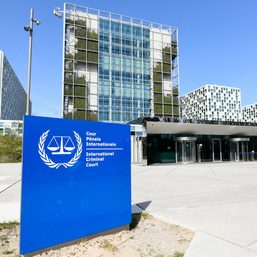SUMMARY
This is AI generated summarization, which may have errors. For context, always refer to the full article.

MANILA, Philippines – President Ferdinand Marcos Jr.’s economic managers have repeatedly touted the bright economic prospects of the Philippine economy.
In an economic forum last May 27, Finance Secretary Ralph Recto said the Philippines is on course to “becoming an upper-middle income status by 2025, lifting 14 million Filipinos out of poverty by 2028, and positioning the country as the 13th largest consumer market globally by 2030.”
“The Philippines is expected to become a trillion-dollar economy by 2033 and surpass France to become the 14th largest economy in the world by 2075,” Recto said.
While the economic team has highlighted what the economy could be like five decades from now, sentiment from the business community, so far, has been tepid.
The latest business expectations survey by the Bangko Sentral ng Pilipinas (BSP) revealed that business sentiment turned less upbeat in the second quarter due to softer demand for goods and services, ongoing international conflicts that may push oil prices higher, and a slowdown in business activity due to El Niño.

Sentiment of respondents, drawn from the country's top 7,000 firms, also weakened for the next quarter and the next 12 months amid lower demand for products due to inflation.

Construction and the services sectors were less optimistic due to various factors, including expectations of lower demand for manpower services, higher vacancies of city hotels and resorts, and adverse impact of geopolitical tensions overseas.
The stock market was also relatively dull two years into the Marcos administration. With the lack of catalysts, companies have generally held back their plans to go public.

Inflation was Marcos' first economic headache. Inflation was above the 2-4% target range for 20 months since Marcos became President, and only went down within target last December 2023.
Prices of goods flared up due to a confluence of domestic and external factors, with the poorest households being hit the hardest. As of June, inflation for all income households tempered to 3.7%, but the poorest or bottom 30% income households saw an increase of 5.5%.
Prices of rice, the Filipino household's staple food, remained at double-digit levels, rising to 22.5% in June.
Costs of transportation, electricity, and other household expenses, however, have started to stabilize.
Affordability of housing is another sticky issue under Marcos. Prices of housing units rose to 6.1% in the first quarter of 2024. Various researchers have pointed out that most Filipinos can't find suitable homes near jobs, nor afford the monthly amortizations needed to own them.
Out of the different housing types, prices of duplex houses were the most erratic, jumping by 36.2%. Condominium units have gone up to double-digits once again, rising by 10.2%.
Unemployment under the Marcos administration has remained low, but the quality of jobs and wages remains in question.
As of May 2024, the unemployment rate stood at 4.1%, equivalent to 2.1 million jobless Filipinos. This is an improvement from the 4.3% posted last May 2023, equivalent to 2.17 million unemployed people.
The underemployment rate fell to 9.9% in May 2024 from 11.7% in May 2023. There are currently 4.8 million employed Filipinos looking for more hours of work.
The recent P35 minimum wage increase was met with strong criticisms, with labor groups calling the hike "laughable."
To improve the quality of life of Filipinos, the government needs to spend for infrastructure and social services.
Marcos, however, is operating under a tight fiscal space amid mounting debt. His predecessor, former president Rodrigo Duterte, borrowed a total of P6.8 trillion during his term, leaving Marcos with the problem of managing debt while maintaining economic growth.
As of end-May, national government debt ballooned to P15.35 trillion. Of the total debt stock, 31.96% was external debt while 68.04% was domestic debt.
Since the pandemic, the government accumulated debts that were falling due in the near term, instead of those with longer tenors.
The government's economic managers, however, are confident that the country's debt pile is manageable. The debt-to-GDP ratio, which looks at debt relative to the size of the economy, is currently at 60.2%. The lower the ratio, the better the government's ability to service debt.
To lower the financial pressure brought about by debt, the Marcos administration needs to find new revenue sources.
Data from the Department of Finance showed that government expenditures are rising much faster than government revenues, resulting in a wider deficit.
Marcos and his economic team will have to look for new revenue sources and improve tax collection to lower the deficit.
– Rappler.com
Add a comment
How does this make you feel?




![[OPINION] Marcos delivered a SONA applauded by critics. It’s all about contrasts.](https://www.rappler.com/tachyon/2024/07/tl-sona-applausse.jpg?resize=257%2C257&crop_strategy=attention)


![[Just Saying] Marcos administration must assist ICC investigation](https://www.rappler.com/tachyon/2024/07/thought-leaders-marcos-must-assist-icc-07312024.jpg?resize=257%2C257&crop_strategy=attention)

![[Vantage Point] Does Meralco favor imported LNG?](https://www.rappler.com/tachyon/2024/07/thought-leaders-does-meralco-favor-lng.jpg?resize=257%2C257&crop_strategy=attention)

![[EDITORIAL] Apat na taon na lang Ginoong Marcos, ‘di na puwede ang papetiks-petiks](https://www.rappler.com/tachyon/2024/07/animated-bongbong-marcos-2024-sona-day-carousel.jpg?resize=257%2C257&crop=280px%2C0px%2C720px%2C720px)
![[In This Economy] Delulunomics: Kailan magiging upper-middle income country ang Pilipinas?](https://www.rappler.com/tachyon/2024/07/in-this-economy-upper-middle-income-country.jpg?resize=257%2C257&crop=421px%2C0px%2C1080px%2C1080px)

There are no comments yet. Add your comment to start the conversation.